The global marketplace has evolved in ways of doing business, and SaaS tools are one factor driving this change. Business owners are no longer necessarily required to buy expensive software, carry out tedious hardware maintenance, or hire expensive IT staff. This is because SaaS allows users to manage tasks such as design, publishing, and direct mail marketing on their own, requiring minimal technical skills or costly resources—just an internet connection.
This innovation means that companies, whether big or small, can focus on making informed decisions for customer satisfaction and business growth.
Many SaaS tools are on the market, but picking out the right one can be tricky for businesses, especially regarding relevance, ROI, and cost-effectiveness. As a full-service SEO agency generating leads for tech and SaaS companies, we’ve worked with hundreds of SaaS tools and can recommend a few to enhance your workflow and help you stay ahead.
What are SaaS Tools?
SaaS (Software as a Service) is typically a cloud-based application offering a particular solution or set of business solutions. They are usually sold on a subscription basis, ranging from one month to one year, allowing businesses to manage costs more predictably.
SaaS solutions may impact different business sectors, such as project management, human resource management, customer relationship management, web development, web design, data analytics, communication, etc. Some examples of these tools include Canva, Asana, Jira, HubSpot, and Slack.
Because SaaS tools are accessible via the internet, they can be used anywhere, making them ideal for remote work and collaboration. They can also be integrated with other cloud-based services, enabling businesses to create seamless workflows across different applications.
While many SaaS tools are readily available for businesses, it’s important to harmonize them to drive productivity. That said, let’s take a look at the various categories of SaaS tools and the best options in each category.
SaaS HR Tools
Every business establishment battles with functionalities like job posting, screening, hiring, onboarding, payroll processing, performance management, benefits administration, and compliance tracking. Human resource (HR) software is designed to streamline and automate these processes, making it easier for businesses to manage their workforce effectively.
In other words, these tools not only save time but also enhance accuracy and ensure that HR teams can focus on strategic initiatives rather than administrative tasks.
1. Zoho People

Zoho People provides agile human resource management for businesses of all sizes, with features like:
- Employee Database Management: Store employee information in one place for easy access and management.
- Attendance and Time Tracking: Track employee attendance, manage leave requests, and monitor work hours.
- Performance Management: Set goals, review performance, and give feedback to improve employee performance.
- Customizable Workflows: Automate repetitive HR tasks with customizable workflows to save time
- Integration with Other Zoho Tools: Connect with other Zoho apps like Zoho Payroll and Zoho Recruit for an improved HR experience
We can speak of Zoho People’s flexibility and affordability, but what’s even more special about the tool is its handling of customer data with utmost integrity and privacy.
2. Workday HCM
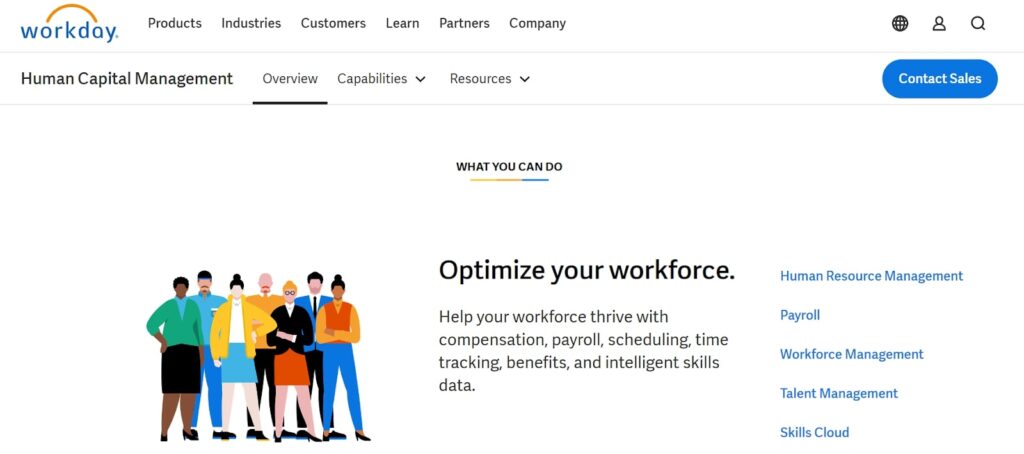
Workday HCM (Human Capital Management) is a powerful, cloud-based HR software catering to SMEs and large enterprises. It provides an extensive suite of HR tools that support the entire employee lifecycle, including:
- Talent Management: Recruit, onboard, and develop talent with integrated tools that support career development and succession planning.
- Payroll and Benefits Administration: Manage payroll, benefits, and compensation with automated tools that ensure accuracy and compliance.
- Workforce Planning and Analytics: Use data to make smart decisions about workforce planning and talent strategy.
- Global Compliance: Abide by local labor laws and regulations in different regions.
We used Workday HCM to automate complex HR tasks and gain valuable insights throughout the employee lifecycle. Its scalable, data-driven, and AI-powered features make it suitable for businesses of all sizes, from small to large.
3. BambooHR

BambooHR is an easy-to-use HR software for small and medium-sized businesses. It simplifies key HR tasks like:
- Employee Onboarding: BambooHR makes it easy to find, hire, and onboard top talent. With its applicant tracking system and onboarding tasks, you can ensure a positive candidate experience and smooth first days for new hires.
- Time Off Management: Easily track employee vacation and sick days with a self-service portal.
- Performance Management: Set goals, conduct reviews, and gather feedback to help employees grow and succeed.
- HR Reporting: Create reports on employee data to help HR teams make informed decisions.
We highly recommend BambooHR for its simple interface and focus on essential HR tasks. It’s a popular choice for businesses seeking a straightforward HR solution that boosts productivity and employee engagement.
4. Deel

Deel is a SaaS tool that makes managing global payroll and compliance for remote teams easier. Key features include
- Global Payroll: Automate payments for employees and contractors in over 150 countries.
- Compliance Management: Stay compliant with local labor laws, tax regulations, and employment standards across countries.
- Contractor Management: Manage contracts, payments, and tax forms for contractors, all within a single platform.
- Localized Benefits: Provide country-specific benefits to attract and keep talent.
Deel is especially useful for teams spread across different countries. We use it to manage our global team efficiently and minimize legal and financial risks.
SaaS Project Management Tools
Companies of all sizes have internal or external projects that they must deliver within a given time and budget. If, for instance, your company is trying to launch a new product, project management tools help plan, execute, and track this sort of project efficiently. They provide the structure and organization needed to manage everything from small tasks to large, complex ones.
For example, a marketing team launching a new product might use a project management tool to handle content creation, social media campaigns, and event planning while ensuring that deadlines are met, resources are used effectively, and all stakeholders are informed throughout the project lifecycle.
5. Asana

Asana helps your team organize work, track progress, and focus on goals. Key features include,
- Task Management: Create tasks, assign them to team members, set deadlines, and track progress in real-time.
- Project Timelines: Use Gantt charts to visualize timelines, see how tasks fit together, and adjust plans as needed.
- Custom Workflows: Create workflows that fit your team’s process so everyone knows what to do next.
- Integration with Other Tools: For an easier work environment, integrate with Slack, Google Drive, and Microsoft Teams.
To add to these amazing features, Asana also helps with improved collaboration, increased transparency, and the ability to manage simple and complex projects efficiently.
6. Basecamp
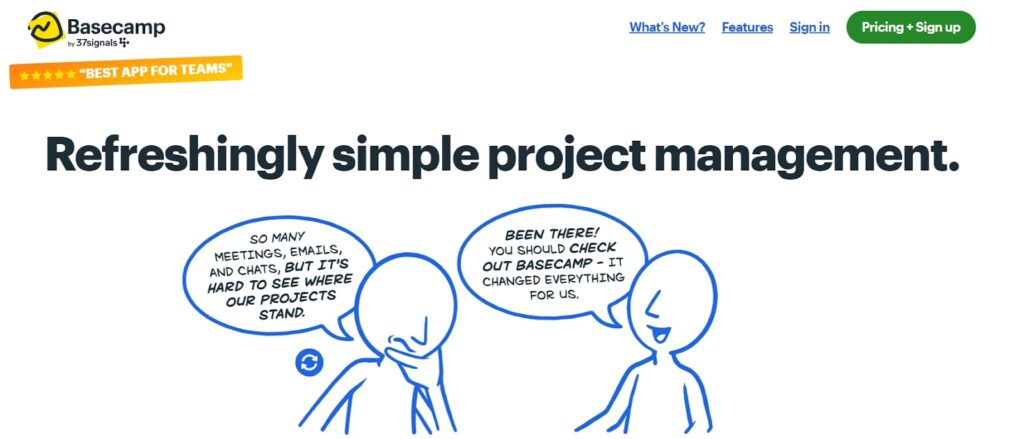
Basecamp is a project management and team collaboration tool designed to keep all project-related information in one place. Its features include:
- Centralized Communication: Keep conversations, files, and tasks organized in dedicated project spaces to reduce the need for long email threads.
- Task Lists: Break down projects into manageable tasks, assign them to team members, and track their progress with simple to-do lists.
- File Storage: Store and share documents, images, and other files within the project, making it easy for team members to find what they need.
- Message Boards: Use message boards to discuss ideas, share updates, and get feedback, all within the project space.
We love how Basecamp reduces communication gaps and helps us organize and manage multiple projects simultaneously.
7. Trello
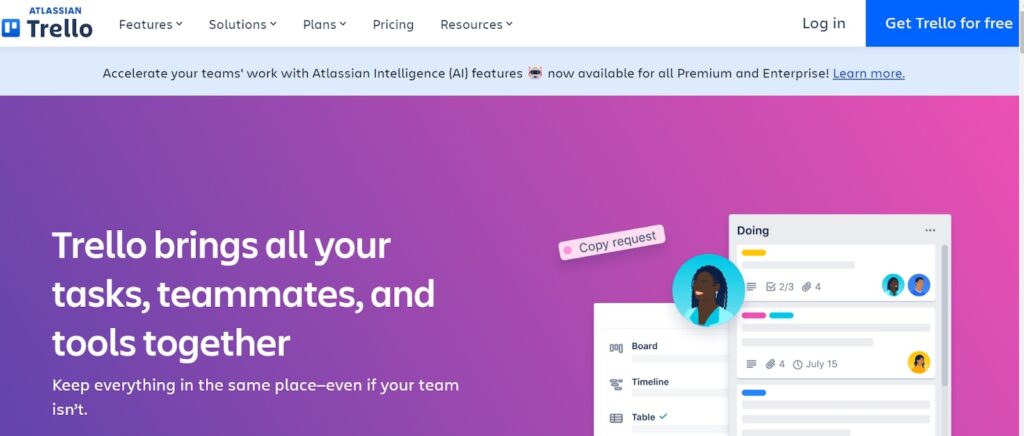
Trello is an easy-to-use project management tool that uses boards, lists, and cards to help teams organize their work. With Trello, you can access features like
- Kanban Boards: Visualize your projects with customizable boards that represent different stages of the workflow, such as “To Do,” “In Progress,” and “Done.”
- Card System: Create task cards, add details, and move them across the board as work progresses.
- Power-Ups: Extend Trello’s features with integrations like Slack, Google Calendar, and Salesforce.
- Collaboration Tools: Add team members, assign tasks, and communicate directly within the cards to keep everyone on the same page.
Trello’s simplicity and flexibility make it suitable for teams looking for a straightforward way to manage projects, especially those using the Kanban method.
8. Jira
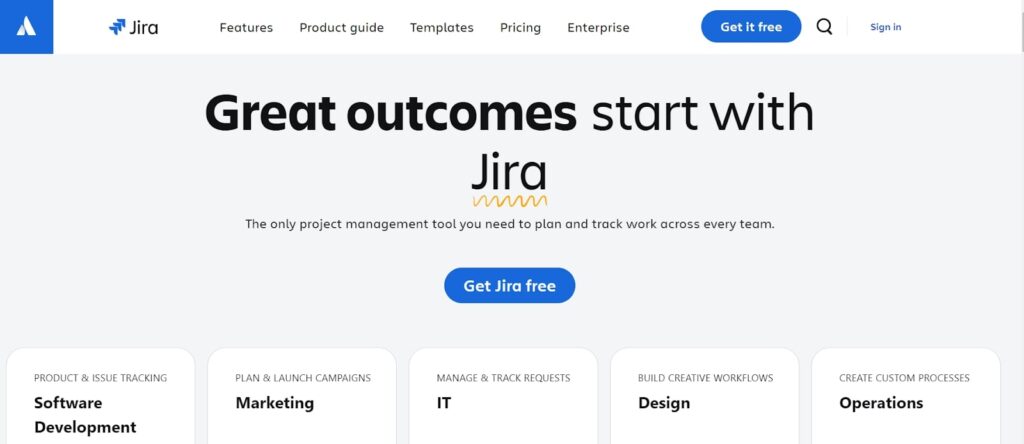

Jira is a robust project management tool tailored specifically for software development teams. It offers a wide range of features to support agile project management, including:
- Scrum and Kanban Boards: Use Scrum boards for sprint planning and Kanban boards for continuous workflow management. Both can be customized to fit your team’s processes.
- Issue and Bug Tracking: Track and manage issues, bugs, and tasks throughout the development lifecycle to ensure that nothing falls through the cracks
- Roadmaps: Create and share project roadmaps to align the team on long-term goals and track progress over time.
- Integration with Development Tools: Jira works with tools like GitHub, Bitbucket, and Jenkins to manage and deploy code smoothly.
The tool provides enhanced visibility into the development process, improved team coordination, and the ability to manage complicated software projects with agility.
SaaS Analytics Tools
Businesses nowadays rely heavily on data to make informed decisions, optimize processes, and drive growth. However, the amount of data generated can be overwhelming. This is where SaaS data analytics tools come into play. These tools will help your business collect, analyze, and visualize data, transforming raw information into actionable insights. Whether you’re tracking website performance, understanding customer behavior, or analyzing sales trends, SaaS analytics tools provide the clarity needed to make important decisions.
9. Google Analytics

Google Analytics is arguably the most widely used web analytics tool, offering deep insights into website traffic and user behavior. With this tool, you can access the following:
- Real-Time Data Tracking: Monitor website activity in real-time, including the number of active users, their locations, and the pages they are viewing.
- Audience Insights: Gain detailed information about your website visitors, such as demographics, interests, and behavior patterns, to direct your content and marketing efforts appropriately.
- Traffic Sources: Find out where your traffic comes from, like search engines, social media, or ads, and adjust your marketing strategies.
- Goal Tracking: Set and track goals, such as form submissions or product purchases, to measure your website and marketing success.
- Custom Reports: Create custom reports and dashboards to visualize the metrics that matter most to your business.
What we love about this tool is the free access it gives us to the most important thing any business needs to succeed: comprehensive data coverage. You can combine data from various sources by integrating Google Analytics (GA4) with other tools like CRM, marketing platforms, and e-commerce apps. This unified view helps you see the entire customer journey and gain valuable insights.
10. Tableau

It’s one thing to access data but another to visualize it. Tableau is a powerful data visualization tool that enables businesses to create interactive, easy-to-understand dashboards and reports.
- Data Connectivity: Connect to various data sources, including Excel, SQL databases, cloud services, and more, to gather all your data in one place.
- Interactive Dashboards: Build visually engaging dashboards where users can explore and filter data in real-time.
- Advanced Analytics: Use Tableau’s built-in analytics capabilities to run complex calculations, identify trends, and uncover hidden insights.
- Collaboration Tools: Share dashboards with your team to interact and collaborate on decisions.
- Mobile Access: Access your dashboards on mobile devices to stay informed and make decisions anywhere.
Tableau allows us to quickly spot trends and patterns in data using charts, graphs, and maps. It also helps us present data clearly to non-technical audiences, avoiding confusion.
Web Tools
A business website is more than just an online presence; it is an important aspect of your branding, marketing strategy, and customer engagement. A well-designed website can attract customers, deliver your brand message, and convert visitors into loyal clients. But then, achieving this requires more than just a basic site—it demands a focus on user experience and responsiveness. This is where web tools like Figma and WordPress come into play. These tools help business owners design and manage websites that are visually up to the mark, highly functional, and user-friendly.
11. Figma

Every dedicated developer or designer must have used (or at least heard about) Figma, a go-to web tool for collaborating on product development and design.
- Collaborative Design: Figma lets multiple team members work on a design at the same time, making real-time collaboration easy, especially for remote teams.
- Prototyping: It helps create interactive models that show how a website or app will function. This will enable stakeholders to see the final product before development.
- Responsive Design: Design layouts that automatically adjust to look great on both mobile and desktop devices.
- Design Systems: Create consistent design systems with reusable components that can be used across projects to maintain brand consistency.
- Cloud-Based Access: Since Figma is cloud-based, you can access your designs from anywhere, making it easy to work on the go or share with clients.
Our design and development team has recorded significant success since we started using Figma in 2018, and your team can also reap its benefits.
12. WordPress
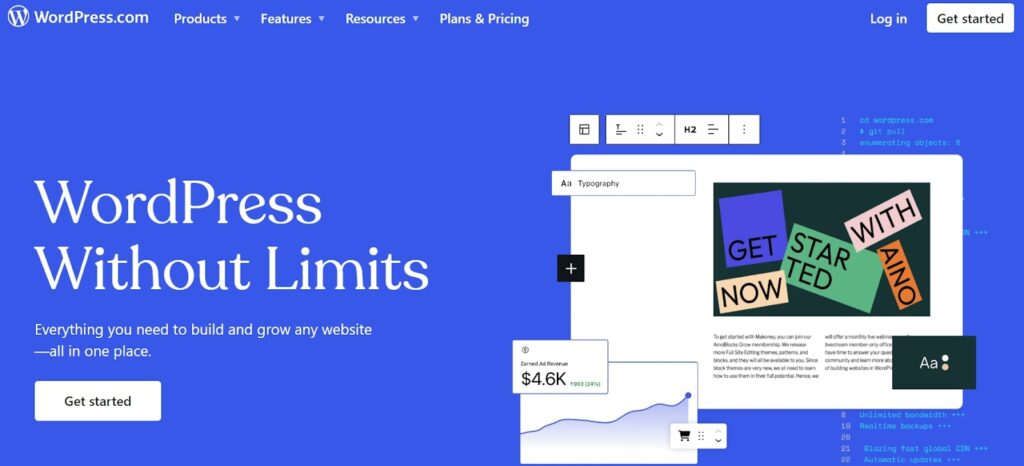
WordPress is a highly versatile content management system (CMS) that powers over 40% of all websites on the internet. A few features to expect from this tool include,
- Customizable Themes: Choose from thousands of free and premium themes to create a website that matches your brand’s personality and aesthetic demands.
- Plugins and Extensions: Add features like SEO, e-commerce, and contact forms with over 58,000 plugins.
- Responsive Design: Most WordPress themes are responsive, so you can expect your site to look good on any device.
- Content Management: Easily create and edit content with WordPress’s user-friendly editor—no coding needed.
- SEO-Friendly: WordPress is optimized for SEO with clean code, customizable URLs, and helpful plugins.
We appreciate WordPress’s flexibility, user-friendliness, and scalability. But what we love even more about this tool is how we can design consistently with Auto Layout, create AI-powered prototypes, and embed them in presentations. WordPress provides the tools you need to succeed, whether you’re building a simple blog, a portfolio site, or a complex e-commerce platform.
Before You Go
Every business needs the right SaaS tools for efficiency and growth. To choose wisely, know your goals—like better collaboration, insights, or an online presence—and match them with your budget.
If you need guidance in selecting and implementing the best tools for your business, our team is here to help. We offer personalized consultations to find the tools that will help you succeed. Book a session with us today to start optimizing your business with the right SaaS solutions.





